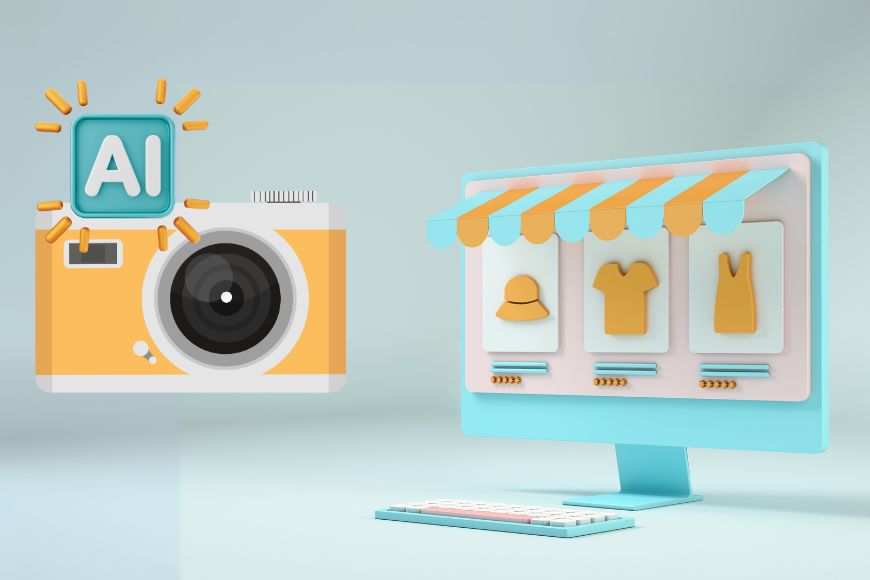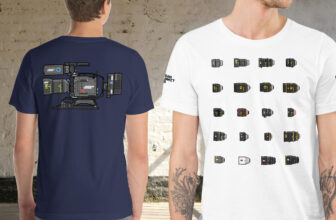
Check out our latest products
If there’s one thing that can make or break an e-commerce business, it’s photography. People can’t physically see or touch the product before buying it. So, they rely on the visuals you provide.
Whether it’s your website, social media channels, or a marketplace like eBay or Amazon, you need to provide high-quality images if you want to succeed.
Not every seller has the budget for regular photo shoots, models, and all the other elements that professional photography entails. So, AI-powered tools can be a lifesaver.
In this article, I’ll be discussing six AI-powered tools that can revolutionize your e-commerce shop, whether you’re a budding entrepreneur or you have a large business that keeps scaling.
These tools aren’t just useful for e-commerce sellers. Many product photographers can also benefit from them, as the original product image is still required and must be of high quality.
Once they’ve done that, they can use these tools to offer their clients multiple variations without requiring expensive props and backdrops.
Stock photographers can also use them. In this case, it’s essential to check any restrictions on the stock photography website, though. Not all of them accept generative AI, even if it’s for only part of the image.
So, if you identify yourself with any of the professionals I just described, or you’re simply curious about the e-commerce world, keep on reading.
6 AI Tools for e-Commerce Photography
Here you’ll find six platforms, apps, and software programs aimed at a wide range of professionals within the e-commerce business.
To help you decide which is best for you, I’ve tested each one and laid out their key features, including which ones are free to use (if any), which offer a free trial, and more.
Remember that using generative AI comes with legal and ethical implications – especially if you generate AI ‘human’ models. So, please check the terms and conditions on each platform and use this amazing technology responsibly.
Pebblely
Pebblely is one of the best AI tools for e-commerce photography. I’ll go into a more in-depth explanation of everything you can do with it in just a moment. However, I want to start with some great news: it offers a free plan.
To start, you need to log in. You can do this with your Google account or by providing an email where you’ll receive a one-time code.
On the top right, you’ll see how many images you have left. The free account lets you generate 40 images per month.
As you upload your photo, it will remove the background. It works extremely fast, but it’s not as accurate as others. So, make sure you zoom in and review the cut-out.
If it’s not perfect, click on Refine Background.

You can do this using a manual brush or the magic one – this may take some practice. Click Preview at any point to see how it’s going. When you’re done, click Save Asset.
Now, it’s possible to generate a solid background. This is great for some platforms that request a pure white background, but you can also use your brand colors.
However, the real magic comes with the generative AI tools. You can choose from one of the 40+ themes available, browse the examples for inspiration, or generate something from a reference photo and a text prompt.
Unfortunately, the custom option is not available for free users. However, you can use the themes.
Be aware that each time you click ‘Generate’, Pebblely will create four variations. This means that you only have 10 per month if you’re on a free plan.
Paid memberships allow you to change the number of variations. This way, you can have more control over your credits, and you can also create in bulk.


Select one or more images from the generated options and download them. As a free user, you can do so without any watermarks, but you won’t be able to do much more. The default size is 1024×1024.
Subscribed members can edit the picture, save the image to use as a template, replace the product, upscale the image 2x, resize it, and add a logo. Pebbleby also allows bulk edits, such as adding your logo to multiple photos simultaneously.
This really is a game changer in e-commerce photography. If you’re starting a business and don’t have the budget for professional photoshoots, Pebbleby is an excellent option.
Currently, there are two subscription tiers starting at $15 per month. If you opt for an annual subscription, the first two months are free.
Flair.ai


Flair is an AI design tool that specializes in product content. You can use it to edit your e-commerce shots and to create your marketing campaigns.
The most significant difference you’ll notice when using Flair AI is the drag-and-drop system. This allows you to easily arrange your scenes using images, props, 3D elements, etc.
I love this system; you have more control over the image, and the AI automatically adjusts the lighting, depth of field, and lighting as you add things.


You can sign up for a free trial, which will provide you with one custom model, five generated images, and one video generation.
If your e-commerce sells clothing, you’ll find the on-model photography quite helpful. Simply upload the image of your product and put it on an AI-generated model.
You can also build your AI model so that your photoshoot looks consistent – so far, I’ve only seen this feature on Flair AI.


Another feature I haven’t found on the other tools I’m reviewing is the ability to create CPG product imagery. This allows you to visualize packaging concepts or generate engaging images for your marketing channels.
Another handy feature is the AI ad generator. Just keep in mind that generating an ad costs four times more than creating a simple image, so you’ll only get one shot with your free credits. This is worth considering when deciding whether to upgrade your plan and which subscription tier best fits your needs.
There are also tools to edit your images. You can easily replace the product or the model in any of your pictures. There’s also a Magic Erase feature to remove any unwanted elements, and two upscalers – one for resolution and one that also enhances quality.
Bulk content generation is also available. The real-time preview is limited when you’re using the free trial, and you won’t be able to download your projects unless you subscribe.
There are many membership tiers depending on what you need. The starting price is US$8 per month, but you should review what is included with each one before deciding which one you need.
For example, if your primary use is video generation, then the Pro plan will not suffice, as it only allows for two videos per month. So, check the plans and prices on their official site.
AdCreative.ai
AdCreative AI is a bit more advanced than Pebblely. This is a good option if your e-commerce is already set up, you have a website, a business plan, and some material.
You can also use it to start your business, but you won’t get the highest return. Considering that there’s no free plan, you’ll want to make the most of your investment.
The good news is that there’s a free trial regardless of the membership tier you choose. AI product photoshoots, which are what you get with Pebblely, are just one of the features of AdCreative.
You can also generate text and videos. AdCreative isn’t just a tool to generate content, though. You can also analyze the ads and content you’re creating to predict how it will perform before you publish it.
It also utilizes AI to generate buyer personas, provides insights from your competitors’ websites, and features a compliance checker.
You can also connect your AdCreative account to different platforms and publish directly.


As you can see, AdCreative is not just for e-commerce websites; all sorts of businesses can benefit from it. For now, I’ll focus on the e-commerce photography tools.
You’ll find the most common tools, such as background removal, image and face enhancement, upscaling, and a background generator. For AI generation, you can choose from the available presets or write your own prompt.
The fashion photoshoot feature transforms your ghost clothing photos into catalogue images featuring AI-generated models. You can also generate AI videos from a photo you upload or one that you generated on AdCreative.
Then, you can add an AI-generated test and score the picture to see how it would work as an ad. Of course, this content doesn’t have to be used for advertising; you can also use it to populate your website or your social media.
It’s possible to reformat your videos and images to any size so you can use them wherever you want.
The subscriptions start at US$25 per month with three tiers available. It’s also possible to ask for a custom price with the Enterprise plan.
Photoroom


Photoroom is a mobile and web-based app dedicated to e-commerce photography using AI tools. You can also use it for your marketing campaigns and social media content.
You can try Photoroom with a free account – you can sign in with Google or Apple accounts, or use your email to receive a magic code. Of course, the free version will be limited.
You can provide Photoroom with the URL of your website, and it will import your brand’s information. You can also create your brand’s kit inside the platform if you don’t have a website yet.
One of the most significant restrictions of the free account is that you won’t be able to generate AI backgrounds. However, there are still many things you can do on the free trial.
You can remove the background and save the cut-out to your brand kit. Then, you can choose a solid background or one of the free images available.


Once your product is on the new background, you can also edit the product by adjusting the light and color. There are other effects that will help you blend the cutout, such as shadows or outlines.
Unfortunately, while the shadow tool has many settings, directionality isn’t one of them, and this could be a big giveaway when doing a photo composite. The solution is to use the AI Shadows feature, but this is only available for Pro accounts.
If you also want to make a social media post or a marketing campaign, you can use one of the free templates. The AI will incorporate your product into the image, considering the different planes. Therefore, you don’t need to make masks or deal with layers.
At any point in your project, you can use the before/after feature, which you’ll find on the top menu bar.


I find the resize tool very user-friendly. Instead of giving you formats or aspect ratios, which you might not be familiar with, it gives you platform formats.
You can resize your design for Vinted, Amazon, eBay, TikTok, Instagram, etc. All the most popular marketplaces and social media are available. Alternatively, you can use the Custom resize or a basic format like square, landscape, or portrait.
Once you’re done, you can share the design by granting access to people or generating a link. You can also download it, but only at low resolution if you’re using the free account. It won’t have a watermark, which is great.
To unlock the high-resolution version, bulk editing, and the AI features I mentioned, you can subscribe to a membership for US$89.99 per year. The Pro account has a 7-day free trial.
Canva
Canva is a graphic design platform that you can use for all your communication and marketing needs. It’s also quite helpful if you have an e-commerce website.
While there is a fully functional free account, most of the tools I’m mentioning here are exclusive to Pro users.
First of all, there’s a Brands section where you can keep all the assets that compose your brand’s style – from the logo to the fonts to the color palettes.
Once you have assets in this section, you can use them on your designs and templates – even the AI-generated ones.
As for the e-commerce photography part, you can upload a photo of your product and remove the background. This can be added to any design if you choose to keep it as a cut-out.
Alternatively, there’s also a background generator. Unfortunately, the background doesn’t always match the lighting of the product or generate the appropriate shadows.


However, there is a possibility to relight the product so that it better matches the scene. While it’s not always perfect, it does a good job most of the time.
If it’s not looking right, try generating a new background and include some lighting instructions in the prompt.
If you like the background it has, you can also work on specific elements or replace existing ones with the Magic Edit tool. The Magic Eraser, meanwhile, allows you to remove anything you find distracting.
Using the Magic Expand tool or the Resize tool, you can transform your images so they fit on any platform. If this changes the composition, you can use the Magic Grab to reposition your product.
Unlike the previous suggestions on this list, Canva has some traditional photo editing tools in case the original picture needs some brightening or color adjustment. These are also available for free accounts.
You can share your projects with anyone, even if they don’t have an account. This allows you to easily share any progress without having to download and save multiple versions of your design.


Lastly, you can publish your work on social media right from Canva. It’s possible to use the text-to-paragraph generator to create engaging text and schedule posts for later use.
If you want to give Canva a try, the Pro subscription currently costs $120 per year or $15 per month. There’s also a Team and an Enterprise option.
Luminar Neo
Luminar Neo is a powerful photo editor. Thanks to its intuitive interface and AI tools, there isn’t a big learning curve, allowing you to retouch professional-looking photos for your e-commerce even as a beginner.
To edit images in Neo, you need to import them. When you do this, you can start to create a Luminar Neo catalog. This allows you to keep all the images for your e-shop in a single place and well organized.


Neo has an amazing AI search tool. This might not seem like a big deal when you’re starting out, but as your business grows and time passes, you’ll see how many images you’ll have to handle.
The great thing about this tool is that you only need to describe the picture to find it. So, you don’t need to remember when you took the photo, what you named the file, or anything like that.
Let’s move on to the editing. Unfortunately, Luminar doesn’t have an image generator yet – but don’t worry, there are plenty of tools you can use for e-commerce photography.


First, you’ll find three useful generative AI tools on the right side of the catalog workspace. GenErase will remove any distracting objects from your photo. GenSwap allows you to replace any element in the picture with AI-generated objects that better match the scene.
Lastly, GenExpand will expand the borders in any direction, generating new content. This allows you to crop the image in any format to fit all platforms.
Scrolling down the panel, you’ll also find an upscaler. While online photos don’t require a high resolution, you can use them to increase the quality of a low-res image. Then, you can resize it as you need to optimize it for web use.
Another nice feature is the Presets workspace. Here, AI scans your image and suggests the best presets, which work like filters but can be customized.
Once you move on to the Edit workspace, you’ll find all the traditional editing tools you need. Some great AI features can also help you improve your pictures without editing skills.
Enhance AI is a one-click solution that you may want to check out. You can also check the Portrait section for specific tools if there’s a model in the picture, or the Landscape one if you did the photoshoot outdoors.


I especially enjoy the AI lighting tools in Luminar Neo. You can simulate studio lighting using multiple light sources, thanks to features like Relight AI and Magic Light AI.
These tools let you create the look of a high-end photoshoot, even if the original image was taken in flat, natural light. The Mood tool is also great for maintaining a consistent style across your entire catalog.
Another thing that many people like about Luminar Neo is that you can buy a perpetual license with a one-time purchase. Of course, a subscription plan is also available if you want to receive all the updates for new AI tools.
Pricing also depends on whether you want just the desktop version or access to the mobile app as well. Either way, it’s an affordable option that offers great value for your money.

![[2025 Upgraded] Retractable Car Charger, SUPERONE 69W Car Phone Charger with Cables Fast Charging, Gifts for Men Women Car Accessories for iPhone 16 15 14 13 12, Samsung, Black](https://i1.wp.com/m.media-amazon.com/images/I/61SaegZpsSL._AC_SL1500_.jpg?w=300&resize=300,300&ssl=1)



![[True Military-Grade] Car Phone Holder【2024 Stronger Suction & Clip】 Universal Cell Phone Holder for Car Mount for Dashboard Windshield Air Vent Long Arm Cell Phone Car Mount Thick Case,Black](https://i2.wp.com/m.media-amazon.com/images/I/715PBCuJezL._AC_SL1500_.jpg?w=300&resize=300,300&ssl=1)
![[エレコム] スマホショルダー ショルダーストラップ 肩掛け ストラップホールシート付属 丸紐 8mm P-STSDH2R08](https://i3.wp.com/m.media-amazon.com/images/I/51BMFf06pxL._AC_SL1500_.jpg?w=300&resize=300,300&ssl=1)







